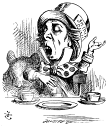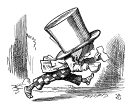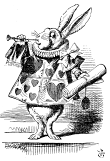Search us!
Search The Word Detective and our family of websites:
This is the easiest way to find a column on a particular word or phrase.
To search for a specific phrase, put it between quotation marks. (note: JavaScript must be turned on in your browser to view results.)
Ask a Question! Puzzled by Posh?
Confounded by Cattycorner?
Baffled by Balderdash?
Flummoxed by Flabbergast?
Perplexed by Pandemonium?
Nonplussed by... Nonplussed?
Annoyed by Alliteration?

Don't be shy!
Send in your question!
Columns from 1995 to 2006 are slowly being added to the above archives. For the moment, they can best be found by using the Search box at the top of this column.
 If you would like to be notified when each monthly update is posted here, sign up for our free email notification list.
If you would like to be notified when each monthly update is posted here, sign up for our free email notification list.
Trivia
All contents herein (except the illustrations, which are in the public domain) are Copyright © 1995-2020 Evan Morris & Kathy Wollard. Reproduction without written permission is prohibited, with the exception that teachers in public schools may duplicate and distribute the material here for classroom use.
Any typos found are yours to keep.
And remember, kids,
Semper Ubi Sub Ubi
|
Not a clue.
Dear Word Detective: I’ve heard the saying “can tell a hawk from a handsaw,” or sometimes “can’t tell…,” but I have no idea what the saying means. Can you help? — Allan Pratt.
Absolutely, no problemo. But first, two questions of my own. One, have you actually heard someone say that phrase aloud (as opposed to reading it somewhere)? Secondly, if the answer is “yes,” where in the world do you live? I’d give my eyeteeth to live among people who actually use phrases like that. I was searching on Google News just now to see if any publications had used the phrase lately, and while only a few had in the past couple of decades, back in the late 19th and early 20th centuries it seems that nearly everyone knew the phrase. By the way, assuming that at some point in the future someone is going to invent a working time machine, why can’t I buy one now?
Meanwhile, back at your question, “to know a hawk from a handsaw” means to be able to correctly perceive reality, to be able to tell things apart, to generally know what’s going on and, at a minimum, not to be nuts. It comes from Shakespeare’s 1604 play “Hamlet,” Act II, Scene 2. Hamlet, who has been acting more than a bit loopy, gets into a conversation with the courtiers Rosencrantz and Guildenstern, in the course of which he hints that his apparent madness may be a tactical pose he adopts at specific times, and not true dementia, saying “I am but mad North North west; when the wind is Southerly, I knowe a Hauke, from a hand saw.”
There is now apparently general agreement that the “hand saw” in that line was originally “heronshaw,” a dialectical English form of “heron,” meaning that Hamlet was contrasting two types of birds, rather than a bird and a carpentry tool. It’s also possible that he meant “heron” to symbolize the prey of a hawk, as he had, at this point in the conversation, figured out that Rosencrantz and Guildenstern, his childhood friends, had been corrupted to his detriment by his murderous uncle.
Despite its apparent genesis as a typographical error, “to know a hawk from a hand saw” gained wide currency almost immediately as an idiom meaning “wide-awake, aware and competent” (“He’s a pretty spruce Fellow, Madam, and … knows a Hawk from a Handsaw, as the saying is,” 1677). Interestingly, Shakespeare had used the same type of metaphor in his earlier comedy “The Merry Wives of Windsor” (“We’ll teach him to know Turtles from Jayes”), but that one didn’t catch the public imagination as “to know a hawk from a hand saw” did. Of course, the alliteration of “hawk” and “hand saw” (or “heronshaw”) didn’t hurt, and neither did the presence of “Hamlet” in the core curriculum of schools for many years.
The underlying sense of “to know a hawk from a hand saw,” that of the ability to accurately perceive things as a measure of sanity, awareness, or being “with it,” has taken many other forms in popular culture. Such venerable phrases as “to know the time of day” (1897) or “to know what’s what” (16th century) have been joined by more colorful and jocular measuring sticks such as “to know how many beans make five” (1830), the simpler form “to know beans” (1833), and “to know one’s onions” (1922). The 20th century saw the rise of stronger phrases, most often used in the negative, including “not to know your arse from your elbow” (1930), “not to know one’s rump from a hole in the ground” (1936) and stronger variants, and not to know excrement “from Shinola,” which was a popular brand of shoe polish in the US in the first half of the 20th century. My personal favorite on this theme dials back the vulgarity and goes for the absurd: “Not to know if it’s Piccadilly or Wednesday,” Piccadilly being a street in London (“A piece of ice caught me a devil of a welt on the head and for a moment I didn’t know if it was Piccadilly or Wednesday,” 1918). I know the feeling.
Miss Piggy approves.
Dear Word Detective: I just learned that the word “porcelain” derives from the Latin word for “pig.” There HAS to be an interesting story behind this. Would you please tell it? — Holger, Germany.
Well, we can always hope. But I’ve learned from experience that what I consider “interesting” stories about word origins often produce glazed eyes and long sighs from listeners at parties and family gatherings. Sometimes I actually have to toss in a few spurious sailors and Medieval peasants to forestall an impromptu slumber party.
But hey, who among us doesn’t enjoy a good pig story, eh? And pigs have certainly left their mark on English idioms, although rarely as compliments to the pigs themselves. We speak of living “high off the hog” when we’re prosperous, a phrase referring to the fact that the choicest cuts of the poor pig come from high on its side. But the traditional diet of the pig, kitchen waste, we use as a synonym for something worthless: “hogwash.” While pigs are now known to be among the most intelligent animals, we call a stupid and stubborn person “pigheaded,” and although pigs are rather clean animals when allowed to run free, we call a messy house a “pigpen” or “pigsty.” We even blame the innocent pig for our own poor judgment. We speak of purchasing something of unknown quality as “buying a pig in a poke,” referring to the old scam of selling what is supposedly a suckling pig in a bag (“poke”) to someone too lazy to open and inspect the bag, which actually contains a very angry stray cat. (The same racket gave us “Let the cat out of the bag” meaning to reveal a secret.)
Meanwhile, back at “porcelain,” the American Heritage Dictionary defines the stuff as “A hard, white, translucent ceramic made by firing a pure clay and then glazing it with variously colored fusible materials; china.” Porcelain is known as “china” because it was originally made in China; Portuguese traders introduced it to Europe in the 16th century and dubbed it “porcelain,” but it wasn’t actually manufactured in Europe until the 18th century.
As appealing as it is to imagine our beleaguered porcine pals finally getting some respect and being served dinner on fine china, the “pig-porcelain” connection is actually one step removed from high-end dinnerware. Our English word “porcelain” is derived from the Middle French “porcelaine,” which came from the Italian “porcellana.” That “pocellana” denoted what we call “china,” but it also meant the shell of the mollusk native to the Indian Ocean known as a “cowrie” (from the Hindi “kauri”), whose small, very shiny shells were used as money at one time in that part of the world. Apparently the ceramic “porcelain” was named because its shiny finish resembled that of a cowrie shell. The cowrie shell, in turn, was called “pocellana” because “porcella” in Italian means “young sow” (from the Latin “porcus,” meaning “pig”), and the cowrie shell was thought to resemble, in some way, a small, plump pig. So the “pig” connection is really between the shell and the sow, and has nothing directly to do with fine china.
That’s a bit of a disappointment, but as a consolation prize we have two other words somewhat surprisingly also derived from “porcus.” One is “porcupine,” which came from the Vulgar Latin “porcospinus,” meaning literally “spiny pig.” The other is “porpoise,” derived from the Old French “porpais,” meaning “pork fish,” probably a reference to the resemblance of Flipper’s nose to the snout of a pig.
|
Makes a great gift! Click cover for more.  
400+ pages of science questions answered and explained for kids -- and adults!
FROM ALTOIDS TO ZIMA, by Evan Morris
 
|


 can be found
can be found 




Recent Comments